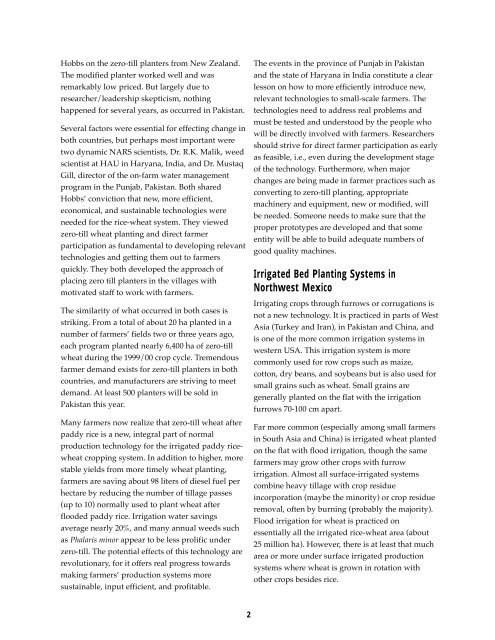Research Highlights of the CIMMYT Wheat Program 1999-2000
Research Highlights of the CIMMYT Wheat Program 1999-2000
Research Highlights of the CIMMYT Wheat Program 1999-2000
You also want an ePaper? Increase the reach of your titles
YUMPU automatically turns print PDFs into web optimized ePapers that Google loves.
Hobbs on <strong>the</strong> zero-till planters from New Zealand.<br />
The modified planter worked well and was<br />
remarkably low priced. But largely due to<br />
researcher/leadership skepticism, nothing<br />
happened for several years, as occurred in Pakistan.<br />
Several factors were essential for effecting change in<br />
both countries, but perhaps most important were<br />
two dynamic NARS scientists, Dr. R.K. Malik, weed<br />
scientist at HAU in Haryana, India, and Dr. Mustaq<br />
Gill, director <strong>of</strong> <strong>the</strong> on-farm water management<br />
program in <strong>the</strong> Punjab, Pakistan. Both shared<br />
Hobbs’ conviction that new, more efficient,<br />
economical, and sustainable technologies were<br />
needed for <strong>the</strong> rice-wheat system. They viewed<br />
zero-till wheat planting and direct farmer<br />
participation as fundamental to developing relevant<br />
technologies and getting <strong>the</strong>m out to farmers<br />
quickly. They both developed <strong>the</strong> approach <strong>of</strong><br />
placing zero till planters in <strong>the</strong> villages with<br />
motivated staff to work with farmers.<br />
The similarity <strong>of</strong> what occurred in both cases is<br />
striking. From a total <strong>of</strong> about 20 ha planted in a<br />
number <strong>of</strong> farmers’ fields two or three years ago,<br />
each program planted nearly 6,400 ha <strong>of</strong> zero-till<br />
wheat during <strong>the</strong> <strong>1999</strong>/00 crop cycle. Tremendous<br />
farmer demand exists for zero-till planters in both<br />
countries, and manufacturers are striving to meet<br />
demand. At least 500 planters will be sold in<br />
Pakistan this year.<br />
Many farmers now realize that zero-till wheat after<br />
paddy rice is a new, integral part <strong>of</strong> normal<br />
production technology for <strong>the</strong> irrigated paddy ricewheat<br />
cropping system. In addition to higher, more<br />
stable yields from more timely wheat planting,<br />
farmers are saving about 98 liters <strong>of</strong> diesel fuel per<br />
hectare by reducing <strong>the</strong> number <strong>of</strong> tillage passes<br />
(up to 10) normally used to plant wheat after<br />
flooded paddy rice. Irrigation water savings<br />
average nearly 20%, and many annual weeds such<br />
as Phalaris minor appear to be less prolific under<br />
zero-till. The potential effects <strong>of</strong> this technology are<br />
revolutionary, for it <strong>of</strong>fers real progress towards<br />
making farmers’ production systems more<br />
sustainable, input efficient, and pr<strong>of</strong>itable.<br />
The events in <strong>the</strong> province <strong>of</strong> Punjab in Pakistan<br />
and <strong>the</strong> state <strong>of</strong> Haryana in India constitute a clear<br />
lesson on how to more efficiently introduce new,<br />
relevant technologies to small-scale farmers. The<br />
technologies need to address real problems and<br />
must be tested and understood by <strong>the</strong> people who<br />
will be directly involved with farmers. <strong>Research</strong>ers<br />
should strive for direct farmer participation as early<br />
as feasible, i.e., even during <strong>the</strong> development stage<br />
<strong>of</strong> <strong>the</strong> technology. Fur<strong>the</strong>rmore, when major<br />
changes are being made in farmer practices such as<br />
converting to zero-till planting, appropriate<br />
machinery and equipment, new or modified, will<br />
be needed. Someone needs to make sure that <strong>the</strong><br />
proper prototypes are developed and that some<br />
entity will be able to build adequate numbers <strong>of</strong><br />
good quality machines.<br />
Irrigated Bed Planting Systems in<br />
Northwest Mexico<br />
Irrigating crops through furrows or corrugations is<br />
not a new technology. It is practiced in parts <strong>of</strong> West<br />
Asia (Turkey and Iran), in Pakistan and China, and<br />
is one <strong>of</strong> <strong>the</strong> more common irrigation systems in<br />
western USA. This irrigation system is more<br />
commonly used for row crops such as maize,<br />
cotton, dry beans, and soybeans but is also used for<br />
small grains such as wheat. Small grains are<br />
generally planted on <strong>the</strong> flat with <strong>the</strong> irrigation<br />
furrows 70-100 cm apart.<br />
Far more common (especially among small farmers<br />
in South Asia and China) is irrigated wheat planted<br />
on <strong>the</strong> flat with flood irrigation, though <strong>the</strong> same<br />
farmers may grow o<strong>the</strong>r crops with furrow<br />
irrigation. Almost all surface-irrigated systems<br />
combine heavy tillage with crop residue<br />
incorporation (maybe <strong>the</strong> minority) or crop residue<br />
removal, <strong>of</strong>ten by burning (probably <strong>the</strong> majority).<br />
Flood irrigation for wheat is practiced on<br />
essentially all <strong>the</strong> irrigated rice-wheat area (about<br />
25 million ha). However, <strong>the</strong>re is at least that much<br />
area or more under surface irrigated production<br />
systems where wheat is grown in rotation with<br />
o<strong>the</strong>r crops besides rice.<br />
2

















